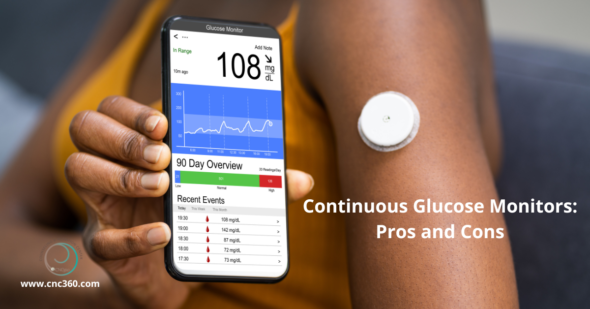With the advent of accessible continuous glucose monitors (CGM) for those with and without diabetes, we all have the opportunity to understand more about how our glucose levels fluctuate throughout the day.
A continuous glucose monitor provides real-time glucose readings every 1 to 5 minutes via a small filament that sits in the interstitial fluid just beneath the skin and is attached to a small sensor and transmitter patch. The CGM patch lasts 10-14 days, and an implantable CGM lasts for 6 months. The glucose data collected is transmitted or scanned to a transponder or smartphone application.
Can a Continuous Glucose Monitor (CGM) work with Intuitive Eating or Interoceptive Awareness?
Interoceptive cues are the clues that your body offers about what is going on inside. For example, interoceptive appetite awareness would be an attunement with the subtle and less subtle cues around hunger and fullness. A body scan when glucose is above or below range, with the curious observation of which symptoms are present during steady and changing glucose can support body trust and attunement.
Symptoms may change and become more pronounced as glucose moves further above or below range. For example, hypoglycemia is defined at glucose <70mg/dl. It can be helpful to start to attune to initial symptoms just below this range that may be less pronounced so that one can respond sooner and recover more quickly from a low glucose. There are symptoms or interoceptive cues that can overlap. For example, hunger can be a symptom of low glucose, elevated glucose, and hunger in the presence of normal glucose levels.
Pros and Cons of Using a CGM
At times, people using CGM may feel surprised that when they thought their glucose was low due to feeling shaky, it was primarily attributed to hunger, but for others this hunger was a strong clue that their glucose was low.
A CGM offers more of a complete picture about what is happening with glucose during the day. A glucose check from a glucose meter can lend insight into matching symptoms with a single data point, whether it is above, at or below target. A glucose check with a meter alone may feel invalidating of physical symptoms if the glucose reading is within normal range (without the added trend arrow data).

A CGM provides a trend arrow to denote whether a glucose reading is trending up, down or steady compared to the prior readings. The trend arrow can validate symptoms if the symptoms are present in the normal range and there is a trend arrow indicating a rising or falling glucose level.
There is little data available about how glucose will vary throughout the day for people without diabetes. For someone without diabetes, a steep rise in glucose after eating may feel alarming. This is an important opportunity to lean into body trust and recognize that the rise in glucose will lead to a signal for the body to produce the necessary insulin to bring the glucose down to target levels. It is also important to understand that if a meal results in a sharp rise in glucose, it could be due to a number of factors including what you ate earlier, portion, what else was in the meal, and the way the food was prepared. This can vary from day to day and it is important to check-in about any food rules or rigidity around food choices that you notice emerging while using a CGM.
CGM can present challenges and is contraindicated in some cases.
Can I monitor this on my own?
Do you have symptoms that you think might indicate an elevated or low glucose, and you want to understand more about the fluctuation of glucose throughout the day?
Hypoglycemia may occur on occasion for people with and without diabetes and can be due to medications or a complication of disordered eating among other causes, with glucose dipping into the 60s or below. A CGM to monitor and alarm if glucose is out of range is an integral tool when a PWD is treated with insulin to understand if medication is adequate to meet the glucose rise after eating and to prevent hypoglycemia.
It is not realistic to expect glucose to flat-line throughout the day, contrary to what some social influences may suggest and display on their feed. Most foods, even those without carbohydrates, will impact glucose.
If someone elects to wear a CGM, it may be due to fear of hypoglycemia (low glucose) or fear of hyperglycemia (elevated glucose) and the potential short- and long-term complications of each.
Mild hypoglycemia (70-55mg/dl) can be treated with the “rule of 15” or 15g of fast-acting carbohydrates such as 3-4 glucose tablets, 1 tablespoon of honey or 1/2c juice, wait 15 minutes, and re-check glucose. For the rule of 15, repeat with 15g carbohydrate if glucose has not risen >80 mg/dl. If glucose dips further more glucose is indicated, as directed by your healthcare team. A prescription glucagon treatment is available if a person is not able to treat it by eating or drinking glucose or fast-acting carbohydrates.
If hypoglycemia or hyperglycemia is occurring, it is important to report this to your PCP or endocrinology team to understand more about it. It may also be helpful to meet with a CDCES who can delve into pattern management with you to understand the story of how glucose is changing during the day and the influencing factors.
Please feel free to reach out to us if you have any questions or concerns about using a continuous glucose monitor.
